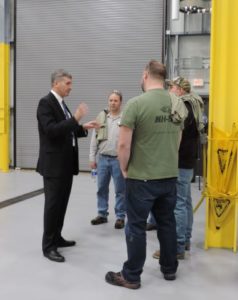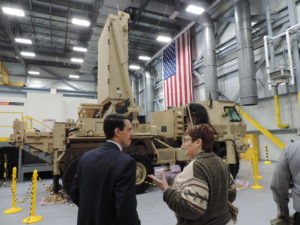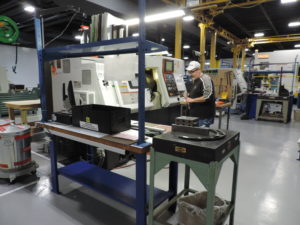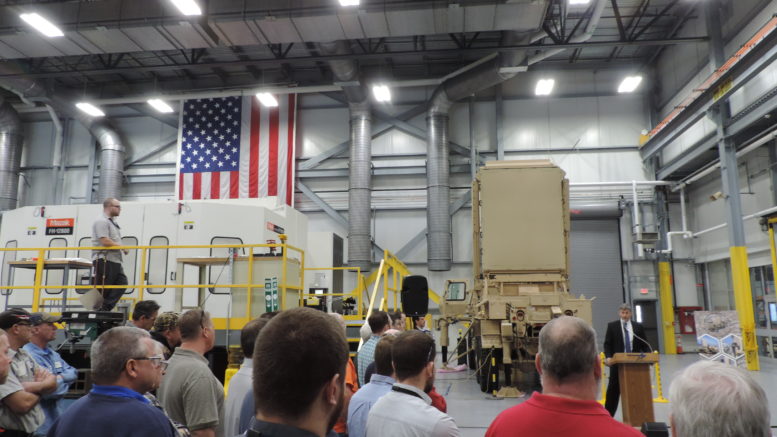
Rick Herodes, program director for the Q-53 radar system at Lockheed Martin in Syracuse, N.Y., speaks with employees at the Owego facility. Manufactured by employees at four sites, the Syracuse location serves as the final assembly point for the Q-53 radar system, while the Owego facility manufactures key parts.
Lockheed Martin, located in Owego, N.Y., held a press conference and employee meeting on Feb. 2 in recognition of a significant milestone, the manufacture of the 100th Q-53 radar system for the U.S. Army.
Lockheed Martin won the Q-53 development contract in 2007. With 104 units under contract, Lockheed Martin is working with the U.S. Army for a full-rate production award in 2017, which will bring the Q-53 system total to more than 170.
In November, the U.S. Army awarded Lockheed Martin a $28 million contract upgrade for “quick reaction capability to add counter-unmanned aerial system” to the Q-53 radar system.
The Q-53 state-of-the-art radar system, carried on trucks, has been deployed with U.S. troops since 2010 and helps soldiers detect, track and determine the location of enemy indirect fire, providing troops on the front lines with either 360-degree or 90-degree monitoring capabilities.
Following reports from the U.S. Army in Iraq and Afghanistan that 360-degree capability was critically needed, the Q-53 replaced two older radars, the Q-36 and Q-37, which had more limited scanning ability. To address emerging threats, including unmanned aerial systems, and to meet various missions, radar systems such as the Q-53, with flexible designs, can be adjusted utilizing software modifications.

From left, Mark Felice, senior manufacturing manager at Lockheed Martin in Owego, N.Y., chats with an employee about the Q-53 radar system.
Manufactured by employees at four sites, the Syracuse location serves as the final assembly point while the Owego facility manufactures key parts. Owego manufactures the rotating platform, or the structure that the radar antenna sits on and spins. Detailed machine parts are fabricated, followed by an extensive assembly process. Owego also fabricates the radar frame and produces the columns that support all of the internal hardware, along with antenna elements, and other key parts.
Mark Felice, senior manufacturing manager at the Owego facility, shared, “It is an important program for us. Not only for the workload and people it employs, but also because of the skills that are required to do the manufacturing.”
Felice explained that the manufacture of Q-53 hardware touches every process in Owego’s advanced machining center, from very small, detailed parts to very large structural pieces that exceed eight feet in length. All needs such as welding, sheet metal, surface treatment, assembly and painting are focused on within the state-of-the-art machine center.

Pictured is an employee inside Lockheed Martin’s advanced machining center in Owego, N.Y. The manufacture of the Q-53 hardware touches every process, from very small, detailed parts to very large structural pieces. The state-of-the-art machine center focuses on all needs such as welding, sheet metal, surface treatment, assembly and painting.
Rick Herodes, program director for the Q-53 radar system in Syracuse, commented, “The reliability of the Q-53 is better than any radar that I have worked with.”
Herodes shared that positive feedback received from the U.S. Army, even in the Q-53’s first days in use made a considerable difference, and in particular, has made an overall difference in the lives of soldiers.
“It’s all about our soldiers,” Herodes said, and added, “The attention and detail is a testament to every Lockheed Martin employee. It’s a tremendous achievement and team effort.”



Be the first to comment on "Lockheed Martin marks milestone with 100th Q-53 radar system for the U.S. Army"